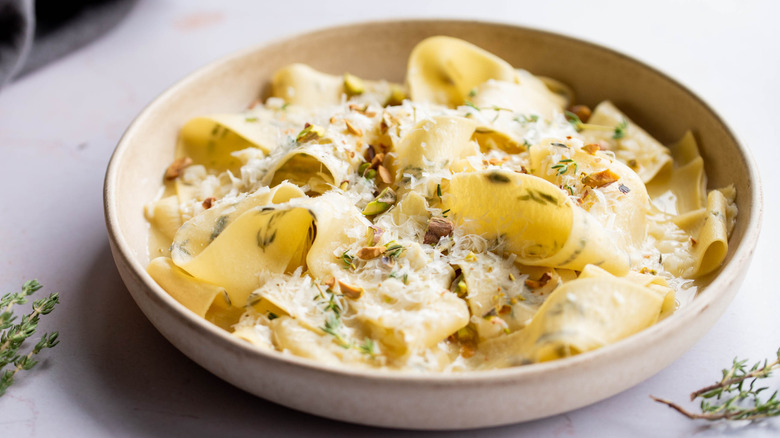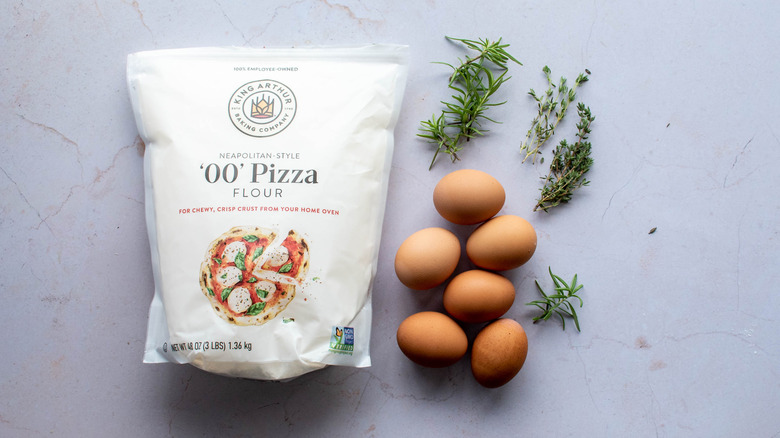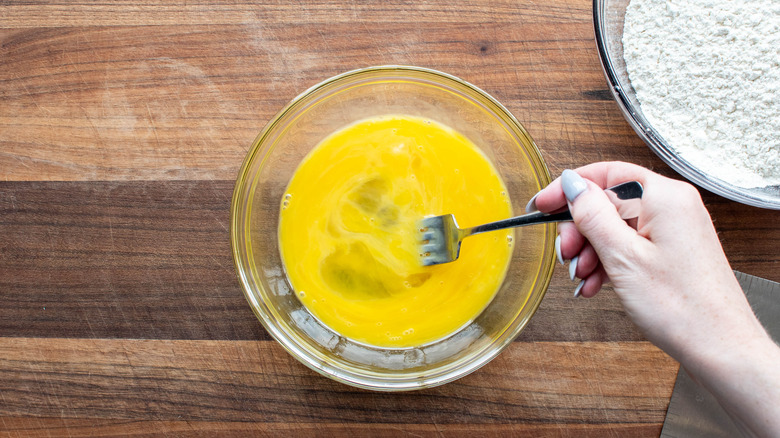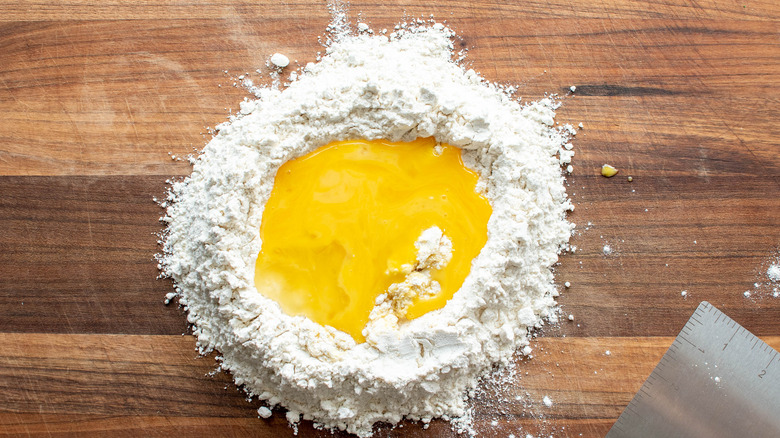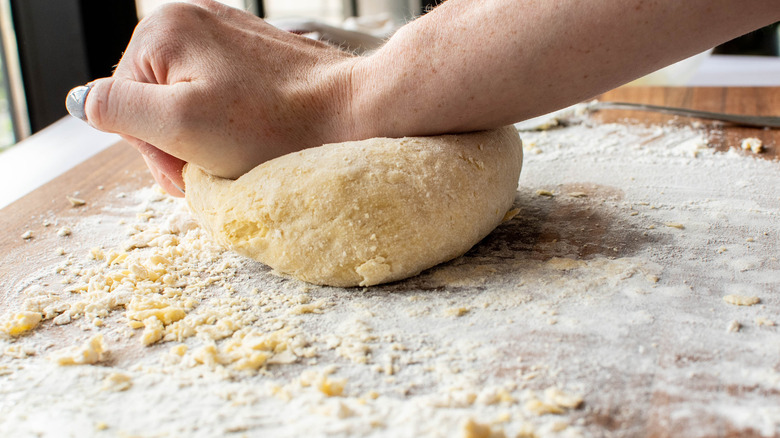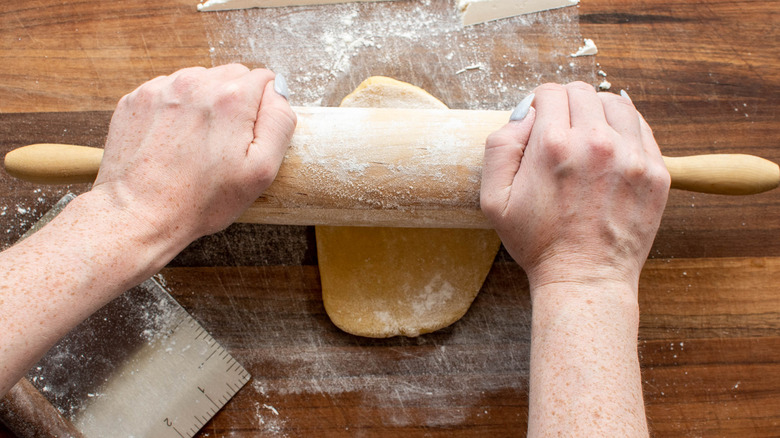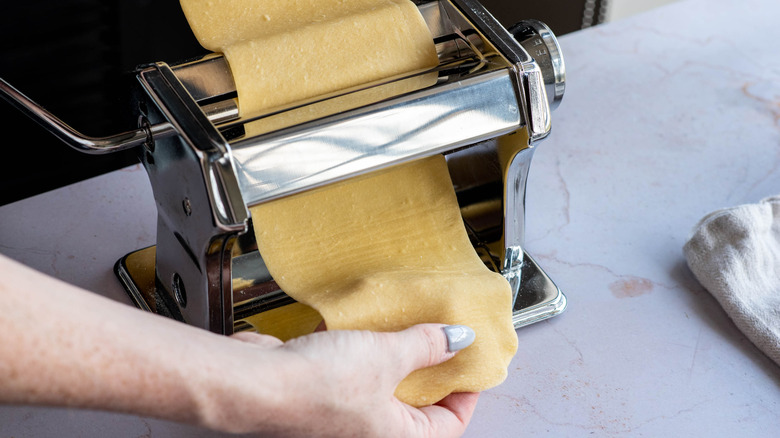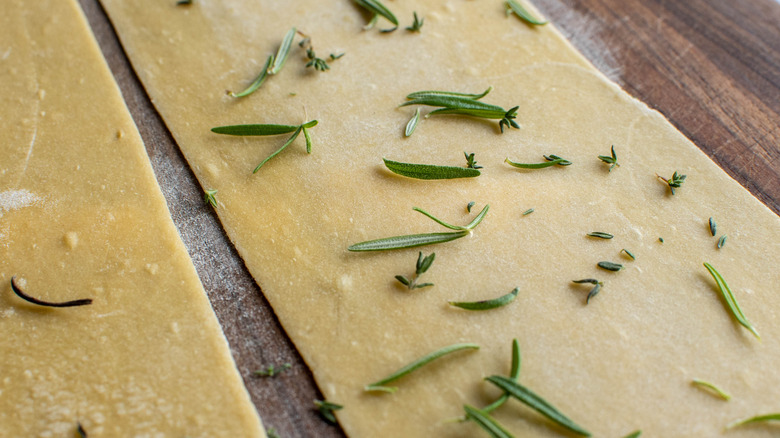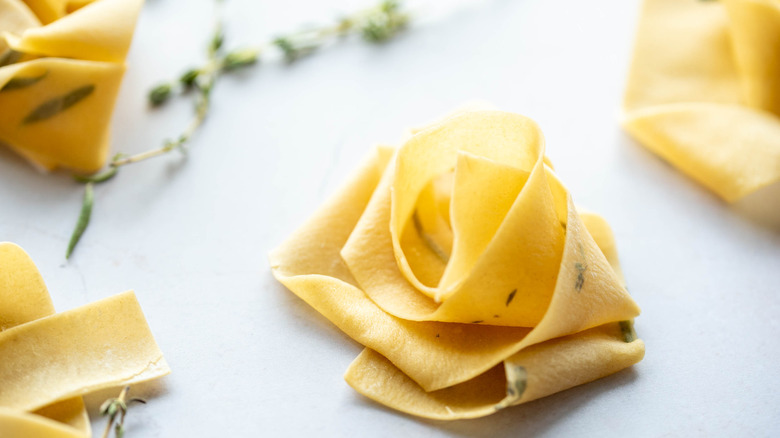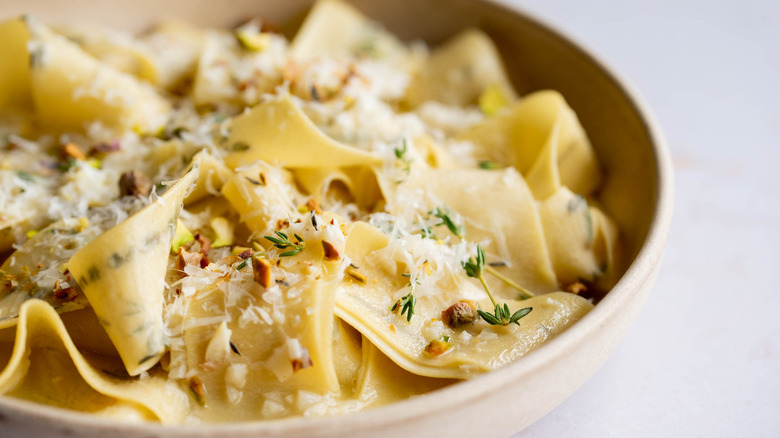Homemade Pasta Recipe
There's just something about homemade pasta that hits the spot. There's no doubt that making pasta at home can be a great way to bring a family or group of friends together for a pasta-making party, and at the end of the evening, you get to enjoy all your hard work and efforts. Recipe developer Michelle McGlinn came up with the perfect homemade pasta recipe with an infusion of herbs that add oodles of flavor to your noodles. "I could go on and on about how much I love making pasta. It is a very intimate, loving, precious thing to put your effort into. Every step requires patience, technique, and skill, and all that time results in just one or two dinners' worth of pasta," McGlinn shares. "However, fresh pasta is infinitely better than any boxed pasta and will be so rewarding to enjoy. This is perfect for date night because it is so special — and because it really helps to have extra hands!"
So, what makes homemade pasta so much better than the boxed stuff? McGlinn explains it best: "Homemade pasta is better because you can control all of this texture with your recipe and achieve a super silky, fresh tasting pasta." McGlinn shares. She also raves about the freshness, and notes that the whole experience is "very rewarding." There's nothing better than feeling proud of a delicious meal, so let's get right into it!
Gather the ingredients for this homemade pasta
Take a trip to the grocery store and gather the ingredients for this wonderful recipe. You will need "00" flour, egg yolks, whole eggs, fresh rosemary, and fresh thyme. "With '00' flour and my recipe for four yolks and two whole eggs, you get a silky, soft pasta, but one that is very manageable to work with and just slightly chewy in texture," McGlinn shares. "It holds heavy sauces well, which makes it great for pappardelle and fettuccini, which are usually paired with ragu and alfredo."
Whisk the egg yolks and add flour
Grab a bowl and add the whole eggs and egg yolks. Using a whisk, mix to break the yolks and then set to the side for the time being.
In the meantime, add flour to a clean work surface. Create a well in the middle of the flour mound and sculpt walls with your hands. The purpose of the walls is to keep the eggs in the middle of the flour.
Mix eggs and flour together
To start, pour half of the egg mixture into the well in the center of the flour and use a fork to begin adding flour from the walls of the well into the eggs. This is the beginning of making the dough. If any egg spills out, just use a bench scraper or knife to add it back to the flour.
Once the egg mixture becomes a paste, add the remaining egg to the well and continue to stir the flour until more of a dough forms. This should take about 5 minutes. If you need, use a bench scraper or knife to help the eggs and flour come together to form a dough.
Knead the dough
Once the dough gets nice and thick, use your hands to knead it. You want it to be soft and pliable. If you find that the dough is too dry, just add a splash of water to make it workable.
To knead, use the base of your palm to push the dough outwards, then fold in half and rotate the dough. Repeat the motion until the dough springs back when pressed into. This should not take more than 5 to 10 minutes.
Wrap the ball and cut the dough
Form the dough into a ball and wrap it in plastic wrap. Let the dough sit in the plastic wrap for about 30 minutes to allow it to soften. If you don't plan on using the dough right away, put it in the fridge and bring it to room temperature about 30 minutes before you plan to use it.
Once 30 minutes are up, unwrap the dough and cut it into four sections. Be sure to reserve three sections in the plastic wrap. Lightly flour a surface and rolling pin and add the first section of dough to the surface. Roll it into a thickness of about ¼ inch, to fit the widest setting on the pasta sheeter.
Add dough to pasta sheeter
In the widest setting of the pasta sheeter, roll the dough through. Once you do that, fold the ends in and pinch one side closed. Then, feed the dough through the widest setting again, this time with the pinched side first. Roll the dough again and continue rolling through each setting until the pasta is thin enough to see your palm through it. Then, use the second to last setting. Roll through twice on this setting, lightly flour the dough sheet, and place it under a damp towel.
Repeat the steps with the remaining dough. If you find the sheets becoming dry, spray with water to rehydrate. You can also add more flour if the dough is too sticky. And if the sheets become too long to work with, cut the dough in half.
Sprinkle with herbs
Once you have rolled all the sheets, lay out one sheet and sprinkle with fresh herbs. Then, lay another sheet on top and gently roll it together with a rolling pin. If necessary, you can cut in half and roll through the last two settings on the pasta sheeter until the dough is translucent again. Sprinkle with flour and place under a damp towel.
Repeat this step with the ten remaining pasta sheets. "The highlighted method here is laminating the herbs into the pasta. It requires some extra time (and more patience) but looks beautiful and directly adds flavor to the pasta — usually even salt is accounted for in the cooking process," McGlinn shares. "It's a good method to use once you've mastered plain pasta and want something special."
Trim the pasta sheets and cook
Grab a ruler and trim the rough edges of the pasta sheet with a pastry cutter or knife. You'll want to cut into 1-inch wide strips of pappardelle. Fold the pieces into nests and dry on a pasta drying rack if you're going to save.
If you want to make the pasta immediately, add the pappardelle to the salted boiling water for 2 to 3 minutes, or until al dente. That's another great thing about fresh pasta — it cooks very quickly!
Serve your fresh, homemade pasta
This pasta goes well with so many things, but we think McGlinn's pairing suggestions are perfect. "I paired this herby pasta with a lemon butter sauce, with lots of garlic, extra thyme, and pistachios. A thin sauce like this is not common for pappardelle but highlights the herbs so well," McGlinn says. "You can also make a ragu or bolognese, which pair well with this sturdy, thick egg dough pasta. I like making short rib ragu with this pasta and serving with salad or roasted artichokes."
McGlinn adds, "You can make the dough up to two days ahead of time and store it in the refrigerator until ready to roll out; then, you will need to let it rest at room temperature for twenty minutes before rolling out. You should use the cut pasta right away or within 24 hours." Whether you make it now or later, we're pretty sure that you're going to love this fresh, homemade pasta recipe.
Homemade Pasta Recipe
Impress your party guests or date by whipping up this fresh homemade pasta.
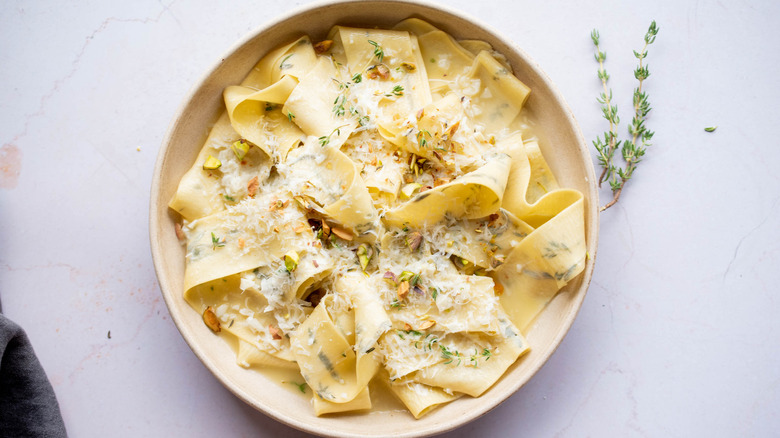
Ingredients
- 2 ¼ cups "00" flour
- 4 egg yolks
- 2 whole eggs
- 3 sprigs fresh rosemary, about 6 tablespoons
- 6 sprigs fresh thyme, about 6 tablespoons
Directions
- Combine the whole eggs and yolks in a bowl and whisk gently together to break the yolks. Set aside.
- Pour flour onto clean surface. Create a well in the center of the flour mound, building up the walls to hold the eggs within the flour.
- Pour about half of the egg mixture into the well and use a fork to begin adding flour from the walls of the well into the eggs, slowly creating the dough. If any egg spills out, use a bench scraper or knife to scrape the egg back in to the flour.
- Once the egg mixture becomes a paste, add the remaining egg to the well and continue to stir the flour into the egg until a dough forms, about 5 minutes. Use a bench scraper or knife to help the egg and flour come together.
- Once the flour and egg have thickened into a dough, use your hands to knead until soft and pliable. If the dough is very dry, add a splash of water until workable. Knead, using the base of your palm to push the dough outwards, then fold in half, rotate the dough, and repeat the motion. Continue this kneading pattern until dough has a Playdoh-like texture and springs back when pushed into, about 5 to 10 minutes.
- Form the dough into a ball and wrap in plastic wrap. Set aside for 30 minutes to allow dough to soften. If not using right away, store in the refrigerator and bring to room temperature for 30 minutes before ready to use.
- After 30 minutes of rest, unwrap the dough, reserving the plastic wrap. Cut into 4 sections and reserve 3 sections in the plastic wrap. Lightly flour a surface and a rolling pin. Roll dough out to about ¼-inch thickness, to fit in the widest setting on the pasta machine.
- In the widest setting of the pasta machine, roll the dough through. Fold the ends in and pinch one side closed, then feed through the widest setting again, pinched side first. Roll through again, then continue rolling through each setting until the pasta is thin enough to see your palm through, the second to last setting. Roll through twice on this setting, then lightly flour the sheet and place under a damp towel.
- Repeat these steps with the remaining dough. If sheets become dry while working, spray lightly with water to hydrate. If the dough is too sticky, lightly flour until workable. If sheets become too long to work with, cut in half and continue rolling.
- Once all sheets have been rolled, lay out one sheet and sprinkle with fresh herbs. Lay another sheet on top and gently roll together with a rolling pin. Cut in half if necessary; then roll through the last two settings used on the pasta machine until dough is translucent again. Sprinkle with flour and place under damp towel. Repeat this process with all of the pasta sheets.
- Using a ruler, trim the rough edges of the pasta sheets with a pastry cutter or knife, then cut into 1-inch wide strips of pappardelle. Fold into nests if using immediately; dry on pasta drying rack if saving.
- To cook, add pappardelle to salted boiling water for 2 to 3 minutes, or until al dente. Dress the pasta up with your favorite sauce, cheese, or toppings.
